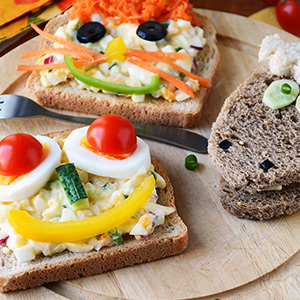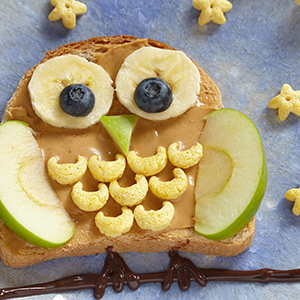Ideas to Please Young Critics

Jimmy’s mother leafed through her cookbooks in a vain search for something her young son might enjoy that night for supper. Still, all sorts of games were played to interest him in the green beans on his plate. Leaving Jimmy alone to finish them off didn’t work, however. His mother returned much later only to find his plate still full, and now quite cold.
Been there? Well, you’re not alone! Lots of parents wonder just what to do when their children balk at eating. Here are a few simple suggestions that may serve to whet young appetites and leave those plates “clean as a whistle.”
Simple Menus for Happy Youngsters
Parents : 0 - Small Fry : 1
- Make meals family time, in a calm atmosphere, without television. Eat seated at the table with your child.
- Don’t replace the rejected meal. Your child may only eat what he or she likes on the plate. But preparing a second meal only encourages capriciousness.
- Stay positive and refrain from comments on his appetite. Neither punish your child for refusing to eat, nor reward him or her for eating. Anticipate complaint, but don’t give in to demands.
- Above all, remember a child must eat when hungry, not when forced or pressured. “Nutritional conflict” often serves as an opportunity for a children to assert themselves. Some children actually benefit from exercising certain negotiation powers in such circumstances!
Yuck! I Don't Like It
- Children welcome familiar foods and must “acquaint themselves” with foods before accepting them. You may need to offer new foods several times before they gain acceptance.
- If refusals persist, try introducing a small quantity of the new element with food already greatly enjoyed. Add Brussel sprouts to a plate of carrots he loves, for example. The carrots will make up part of his daily intake of vegetables even if some Brussel sprouts remain on the plate.
- Calling it “adult food” also works. Explain that tastes change, and that by tasting a little at a time, your child acquire a taste for, or grow to like, certain foods.
- All of us, including children, have a right to our preferences. The trick is to draw a line between capriciousness and outright dislike, however. Above all, set a good example by trying new foods yourself on a regular basis. A child is primarily an imitator...

I Nibble, you Nibble, he Nibbles ?
- Milk, vegetables and meat are among the foods most often turned down by children. Here are a few tricks to help ensure your child gets his or her recommended daily amount of these vital foods.
- Serve raw vegetables with a nutritious dip at snack time – when a child is hungry – or as an appetizer instead of a main course.
- Add them to composite dishes : cut in small slices and incorporate in sauces or omelettes or serve them in soups garnished with designs made with cream. Then, too, it’s worth recalling that children often like vegetable juice.
- Your child says “no” to a large glass of milk? That’s no cause for worry if he or she eats cheese, cream soups, yogurt, frozen yogurt, or milk-based desserts such as rice or tapioca pudding.
- When it comes to meat, serve tender pieces, cooked in a little broth, cut in small bite sized, easy to chew, pieces.
- Meat substitutes sometimes accepted more readily include legumes, tofu, eggs or peanut butter.
Wow! It's Super!
- While keeping it fast and simple, imagine ways to make your child’s plate more appealing. Children love dishes depicting scenes, for example!
- Ham and mashed potatoes might become a sailboat on the sea. Build a log cabin with green beans. Rounds of carrots or pieces of red pepper are fine for a game of tic-tac-toe. Sheppard’s pie topped with a little ketchup takes on the shape of an animal or man, perhaps.
- Serve vegetables, fruit or even meat on mini-kabobs made with toothpicks. Some children find pleasure in eating them like corn on the cob.
- Surprise your children by serving a breakfast menu for supper or by organizing a “picnic at the beach”... right on the kitchen floor, complete with bathing suits and beach towels, of course!
- Serve a simple menu using toy dishes or play “restaurant”, offering red wine (vegetable juice) or white wine (water or milk) in small wine glasses.
- Let your child get involved by giving him or her tasks to perform in preparing and serving the meal.

Some More Good Ideas to Chew on!
- Children enjoy simple dishes. Serve sauces separately, avoid multiple combinations, and do not overload plates in hopes that more will get eaten. That can prove counterproductive if it discourages your child even more.
- Children like individual and coloured yogurt wrappings, drinking yogurt, apple sauce, or cheese sticks.
- Brighten ordinary as well as special days. Use muffin moulds to cook small individual portions : spreads, quiches or mini shepard’s pies. Serve a fish gratin or a chicken and vegetable sauce in small tastefully garnished remekins.
- Mix salty and sweet flavours. Serve orange or honey glazed vegetables or meats with sweet and sour sauce.
- Celebrate special days with nutritious sandwiches trimmed using punchers in varied shapes. Prepare fruit salad jellies in glasses.
- On a plate, tastefully arrange fruit around a small ramekin filled with fruit yogurt dip or chocolate fondu with cream.
- Give amusing names to your recipes and to the dishes you serve.
I'm Hungry! I Want a Snack ?
- Make sure continuous snacking does not interfere with appetite and limit amounts of fruit juices. Serve juices diluted with a bit of water, or pure water with a straw, or in a specially shaped bottle.
- Establish a stable meal and snack schedule. If your child does not eat at meals, he or she should wait for snack time.
- For complete meals, offer a small quantity of nutritious foods chosen according to the four groups in the Canadian Food Guide : vegetables and dip, cheese, fruit, yogurt, milk or a small bran muffin. Avoid foods high in sugar which diminish appetite.
- Also avoid serving snacks less than two hours before the next meal.

A Varied Appetite
- The appetite of a small child can vary from one meal to the next, or from one day to another. No cause for concern if a child is in good physical shape. Loss of appetite almost always coincides with a period of slower growth.
- Our occidental habits push us to consume more than is needed, sometimes leading us to believe small children do not eat adequately. But individual needs vary, and daily requirements are often less than average among small or picky eaters.
- Monitor your child’s diet over a few days rather than panic if vegetables do not get eaten at each meal.
- Bear in mind that parents supply the quality and the child determines the quantity.
- If you still believe that your child eats too little or too badly and that it is hazardous to their health, discuss the matter with a pediatrician or nutritionist.


















